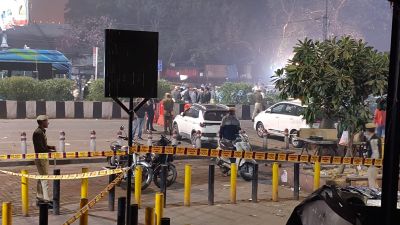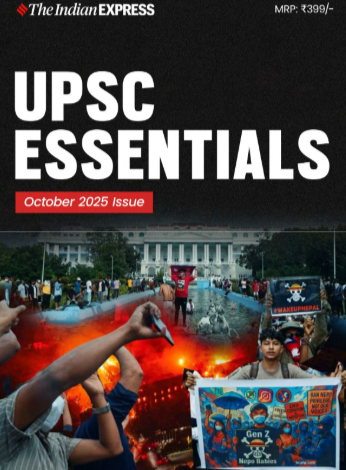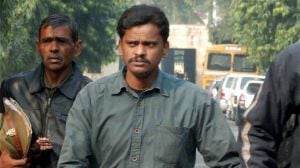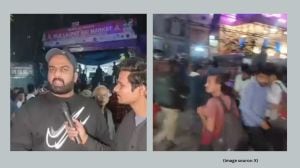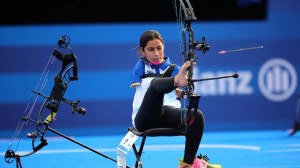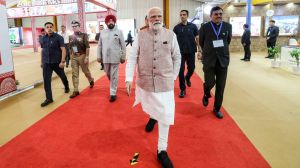
Preliminary Examination: Current events of national and international importance
Mains Examination: General Studies-III: Indian Economy and issues relating to planning, mobilisation, of resources, growth, development and employment.
Story continues below this ad
What’s the ongoing story: The Goods and Services Tax (GST) Council, in its 56th meeting which lasted over 10 hours Wednesday, cleared the next-generation reforms under the eight-year old indirect tax regime. This effectively paves the way for a broad two-slab structure of 5 per cent and 18 per cent with a demerit rate of 40 per cent rate only for super luxury, sin and demerit goods.
Key Points to Ponder:
— Know about the GST
— What is the role and function of the GST council?
— What is the objective of introducing next-generation reforms?
— What are the various tax slabs before and after the reform?
— What is the tax system in India?
— How are decisions taken in the GST council?
— What do you understand about sin goods?
— What is an inverted duty structure?
— What is cess?
Key Takeaways:
— The aim: lower tax burden on common people with sweeping rate cuts and reduction in GST slabs, ease blocked working capital, and facilitate ease of doing business with automated refunds and registration process.
Story continues below this ad
— All the rate changes, except those for tobacco and tobacco-related products, will come into effect from September 22, the first day of Navratri, said Union Finance Minister Nirmala Sitharaman who chaired the meeting that was attended by ministers from 31 states and Union Territories.
— The GST Council announced sweeping rate cuts for common-use items ranging from packaged and branded food items like fruit juices, butter, cheese, condensed milk, pasta, packaged coconut water, soya milk drinks, nuts, dates and sausages, and medical items including medical grade oxygen, gauze, bandages, diagnostic kits (5 per cent from 12 per cent) to nil GST rate for ultra-high temperature milk, chhena or paneer, pizza bread and khakra, plain chapati or roti and education item of erasers from 5 per cent at present.
 Source: CBIC
Source: CBIC
— Other common use items that have also seen GST being reduced to 5 per cent from either 12 per cent or 18 per cent include items such as hair oil, soap bars, shampoos, toothbrushes, toothpaste, bicycles, tableware, kitchenware and other household articles.
— GST has also been reduced for white goods such as air conditioners, television sets, dishwashing machines to 18 per cent from 28 per cent.
Story continues below this ad
— Small cars with engine capacity not exceeding 1200 cc (petrol) and 1500 cc (diesel) and with length not over 4 metre will now be in the 18 per cent slab.
— Another key decision was regarding the blanket exemption provided for life insurance, whether term or life, ULIP or endowment policies for individuals along with exemption for health insurance for individuals including family floater plans and policies for senior citizens.
— Beauty and physical well-being services used by common people such as services of gyms, salons, barbers and yoga centres will now face a lower GST of 5 per cent as against 18 per cent at present.
— With these reforms, the GST will now get rid of the multiplicity of slabs – 5 per cent, 12 per cent, 18 per cent and 28 per cent – with a broad two-slab structure – a merit rate of 5 per cent and a standard rate of 18 per cent – in addition to a special demerit rate of 40 per cent for super luxury, sin and demerit goods such as pan masala, tobacco and cigarettes.
Story continues below this ad
— The streamlining of slabs will help in correction of inverted duty structure – where the tax rate on output supply is lower than the tax rate on inputs and which was affecting the working capital and cash flow of businesses – and numerous classification disputes arising because of the multiplicity of rates and differential rates for similar items, especially in the automotive and food sectors.
— The long-pending correction of inverted duty structure has also been carried out for textiles and fertiliser sectors. GST cuts were announced for the manmade textile sector, with manmade fibre seeing the tax rate being cut to 5 per cent from 18 per cent and manmade yarn to 5 per cent from 12 per cent.
— Tobacco and related products will continue to operate under the current system — along with the additional cess — until the amount borrowed by the government during the pandemic years to compensate states for shortfall in revenue is paid back.
— FM said after the loan repayments are met, there will not be any cess and those items which attracted the compensation cess will attract a special rate of 40 per cent.
Story continues below this ad
— The Central government had borrowed Rs 1.1 lakh crore in 2020-21 and Rs 1.59 lakh crore in 2021-22 as back-to-back loans to meet a part of the shortfall in cess collections.
— As per the Union Budget for 2025-26, the government expects to collect Rs 1.67 lakh crore as compensation cess in the current fiscal, with repayment to the tune of Rs 67,500 crore for these back-to-back loans scheduled for the year.
— Previously, Rs 78,104 crore was paid back in 2023-24 and Rs 1.24 lakh crore in 2024-25, as per the Budget documents.
— Economists, however, have predicted a loss in revenue for the government at both the Central and state level. In a note on August 19, HSBC economists had estimated that the rate rationalisation exercise could cost the exchequer around Rs 1.43 lakh crore, or 0.4 per cent of GDP.
Story continues below this ad
— Asked about the impact of the GST rate cuts on the GDP at the press conference Wednesday, Sitharaman said it was too early to make any calculation
Do You Know:
— The GST regime came into force after the Constitutional (122nd Amendment) Bill was passed by both Houses of Parliament in 2016. It came into effect in 2017 and was billed as an attempt to simplify the existing tax structure in India, where both the Centre and states levied multiple taxes, and to make it uniform.
— The President set up the GST Council as a joint forum of the Centre and the states, under Article 279A (1) of the amended Constitution. It said that members of the Council include the Union Finance Minister (chairperson), and the Union Minister of State (Finance) from the Centre. Each state can nominate a minister in charge, of finance or taxation or any other minister, as a member.
— According to Article 279, the council is meant to “make recommendations to the Union and the states on important issues related to GST, like the goods and services that may be subjected or exempted from GST, model GST Laws”.
Story continues below this ad
— A cess is a form of tax levied by the government on tax with specific purposes till the time the government gets enough money for that purpose.
Other Important Articles Covering the same topic:
📍Explained: What is the GST Council, and what does it do?
Previous year UPSC Prelims Question Covering similar theme:
(1) What is/are the most likely advantages of implementing ‘Goods and Services Tax (GST)’? (UPSC CSE 2017)
1. It will replace multiple taxes collected by multiple authorities and will thus create a single market in India.
Story continues below this ad
2. It will drastically reduce the ‘Current Account Deficit’ of India and will enable it to increase its foreign exchange reserves.
3. It will enormously increase the growth and size of the economy of India and will enable it to overtake China in the near future.
Select the correct answer using the code given below:
(a) 1 only
(b) 2 and 3 only
(c) 1 and 3 only
(d) 1, 2 and 3
Previous year UPSC Mains Question Covering similar theme:
📍Enumerate the indirect taxes which have been subsumed in the Goods and Services Tax (GST) in India. Also, comment on the revenue implications of the GST introduced in India since July 2017. (UPSC CSE 2019)
Syllabus:
Preliminary Examination: Current events of national and international importance
Mains Examination: General Studies-II: Bilateral, regional and global groupings and agreements involving India and/or affecting India’s interests.
What’s the ongoing story: Underlining that “predictability today has a huge premium in global politics”, External Affairs Minister S Jaishankar on Wednesday framed Germany as a reliable partner and said that with the world facing “economic volatility”, there was a “very powerful case” for India and the European Union, and India and Germany to work “much more closely with each other”.
Key Points to Ponder:
— Know about the background of India-Germany relationship
— What is the Tarang Shakti air exercise?
— What are the recent areas of cooperation between India and Germany?
— What is the challenge of labour shortage in Germany?
— What is the migration and mobility agreement between India and Germany?
— What are the challenges in the India-Germany relationship?
Key Takeaways:
— Jaishankar’s remarks, which followed his meeting with German Foreign Minister Johann Wadephul, are a thinly-veiled reference to the unpredictability of the partnership displayed by the US administration under President Donald Trump.
— Citing Wadephul’s interview to The Indian Express, Jaishankar said: “Our two-way trade last year was almost Euro 50 billion. Minister Wadephul is on record, I saw one of his interviews, where he said that he was very confident we will be doubling our trade.”
— Wadephul reaffirmed Germany’s support for India in its fight against terrorism, emphasising that New Delhi has every right to defend its people. “When it comes to India defending itself against terrorism, Germany continues to be firmly at your side,” he said.
— The two ministers also discussed cooperation in semiconductors, student mobility, defence trade and India-EU Free Trade Agreement.
— Speaking on the Ukraine war, Wadephul also urged India to ask Russia to return to peace talks. He said that despite efforts by Europe and the US, Russia hasn’t been willing to enter negotiations, a challenge that New Delhi could possibly address.
— Jaishankar flagged the defence and security cooperation with Germany. “There has been an uptick in our defence and security cooperation. Germany participated in the Tarang Shakti air exercises last year and its ships made port calls to Goa. Today, we agreed that such participation should be continued, indeed, even expanded.”
Do You Know:
— Last year, Germany raised the annual visa quota for skilled Indian professionals from 20,000 to 90,000. The move is designed to make up for labour shortage that Germany might be facing owing to an ageing population.
— In 2014, around 27% of the German population was 60 and above, a number that is expected to touch 35% by 2030, as per statistics.
— Since May 2000, India and Germany have had a ‘Strategic Partnership’ which has been further strengthened with the launch of Intergovernmental Consultations (IGC) in 2011 at the level of Heads of Government.
— Several institutional arrangements exist between India and Germany to discuss bilateral and global issues of interest, namely, Foreign Office Consultations, High Defence Committee, Indo-German Energy Forum, Indo-German Environment Forum, S&T Committee, and Joint Working Groups in various fields, including skill development, automotive, agriculture, tourism, water and waste management.
Other Important Articles Covering the same topic:
📍C Raja Mohan writes: In German chancellor’s India visit, a chance for deeper ties with Berlin
📍Ageing population, labour shortage: Why Germany needs Indian workforce
Prelims practice Question Covering similar theme:
(2) Consider the following countries:
1. Poland
2. Austria
3. Sweden
4. United Kingdom
5. Netherlands
Which of the above touch boundaries with Germany?
(a) 1, 2, 3 and 5
(b) 1, 2 and 5
(c) 2, 3, 4 and 5
(d) 3, 4 and 5
GOVT & POLITICS
Syllabus:
Preliminary Examination: Current events of national and international importance
Mains Examination: General Studies-II: Bilateral, regional and global groupings and agreements involving India and/or affecting India’s interests.
General Studies-III: Conservation, environmental pollution and degradation, environmental impact assessment
What’s the ongoing story: India will enact a new law to safeguard its interests in the international ocean waters following the finalisation of the High Seas Treaty two years ago.
Key Points to Ponder:
— What are the high seas?
— What is the significance of the high seas?
— What is the significance of the High Seas Treaty, also known as the Biodiversity Beyond National Jurisdictions (BBNJ)?
— What measures should be taken to ensure the conservation of marine biodiversity?
— Read about the UN Convention on the Law of the Seas, the Geneva Convention (1958) on the High Seas, and the Paris Agreement.
Key Takeaways:
— The Ministry of Earth Sciences has set up a 12-member drafting committee headed by Supreme Court Senior Advocate Sanjay Upadhyay, one of the leading environment lawyers in the country, to prepare the contours of the new law in accordance with the provisions of the new treaty.
— The High Seas Treaty, also known as the Biodiversity Beyond National Jurisdictions (BBNJ), because it deals with activities in international waters, seeks to curb pollution, and excessive resource extraction, while promoting efforts for sustainable use of biodiversity and other marine resources.
— One of the consequences of the new treaty would be the demarcation of protected areas in high seas, similar to national parks or wildlife reserves. High seas are regions beyond the territorial waters and the Exclusive Economic Zones (EEZs) of a nation.
— These international waters, which constitute about 64 per cent of ocean areas, are considered global commons and are currently free for any kind of activity by any country. Every country enjoys equal rights for navigation, overflight, fishing, setting up infrastructure like undersea cables, and even mineral extraction.
— The High Seas Treaty would result in regulation of certain extractive activities, like sea-bed mining, and also enable the conservation and protection of marine life and resources. It also has provisions for equitable benefit sharing from the use of marine genetic resources, for example.
— The treaty would serve as a legally binding international instrument under the UN Convention on the Law of the Sea (UNCLOS), which is a much broader agreement that extends to all oceans and defines the rights and duties of countries in their use of oceans and their resources.
— India has signed on to the BBNJ but has not yet ratified it. So far, 55 countries have ratified the treaty, which is slated to come into force 120 days after ratification by the 60th country. Enactment of a law is not necessary for ratification.
— The 12-member panel headed by Upadhyay has been mandated to look at the issue of marine environment in a comprehensive manner and draft a law that not just safeguards India’s interests in the oceans, but also promotes conservation of marine resources.
Do You Know:
— It is not that there is no international governance mechanism for the oceans. The 1982 UN Convention on Laws of the Seas, or UNCLOS, is a comprehensive international law that lays down the broad frameworks for legitimate behaviour on, and use of, seas and oceans everywhere.
— It defines the rights and duties of nations regarding activities in the oceans and also addresses issues such as sovereignty, passage rights, and rights of exclusive economic usage. Demarcations of territorial waters and EEZs are a result of UNCLOS.
— The territorial sea (TS) as per UNCLOS, is an area extending up to 12 nautical miles from the base of a country’s coastline. The difference between EEZ and TS is that a state has full sovereignty over the waters encompassed within the TS, whereas with regard to the EEZ, the state merely has exclusive sovereign economic rights to substances lying below the surface of the sea.
— UNCLOS sets the general principles for equitable access and usage of ocean resources, and protection and conservation of biodiversity and marine ecology. But it doesn’t specify how these objectives have to be achieved.
— This is where the High Seas Treaty comes in. The High Seas Treaty will work as an implementation agreement under the UNCLOS, much like the Paris Agreement works under the UN Framework Convention on Climate Change (UNFCCC).
Other Important Articles Covering the same topic:
📍Knowledge nugget of the day: High Seas Treaty
📍India to sign, ratify High Seas Treaty: Minister
Previous year UPSC Prelims/Mains Question Covering similar theme:
(3) With reference to the United Nations Convention on the Law of Sea, consider the following statements: (UPSC CSE 2022)
1. A coastal state has the right to establish the breadth of its territorial sea up to a limit not exceeding 12 nautical miles, measured from baseline determined in accordance with the convention.
2. Ships of all states, whether coastal or land-locked, enjoy the right of innocent passage through the territorial sea.
3. The Exclusive Economic Zone shall not extend beyond 200 nautical miles from the baseline from which the breadth of the territorial sea is measured.
Which of the statements given above are correct?
(a) 1 and 2 only
(b) 2 and 3 only
(c) 1 and 3 only
(d) 1, 2 and 3
EXPLAINED
Syllabus:
Preliminary Examination: Indian Polity and Governance – Constitution, Political System, Panchayati Raj, Public Policy, Rights Issues
Mains Examination: General Studies-III: Various Security forces and agencies and their mandate.
What’s the ongoing story: Delhi High Court on Tuesday declined to grant bail to Umar Khalid, Sharjeel Imam, Gulfisha Fatima, and seven others charged as key conspirators of the February 2020 Delhi riots, saying the riots were a “premeditated, well-orchestrated conspiracy”.
The accused have been charged under various provisions of the Unlawful Activities (Prevention) Act, 1967 (UAPA), including Section 16, which prescribes the death penalty for committing a “terrorist act”.
Key Points to Ponder:
— What is the Unlawful Activities (Prevention) Act (UAPA)?
— What is the rationale for enacting the UAPA?
— At the bail stage in UAPA, the credibility of the evidence cannot be examined, and it must be presumed to be true. What does it mean?
— What are the concerns regarding the UAPA?
— What are the provisions of bail under UAPA?
Key Takeaways:
— The prosecution has argued that the riots were a result of a “deep-rooted” and “well-orchestrated” criminal conspiracy hatched by the accused. Fifty four people, including a senior police officer and an Intelligence Bureau official, were killed, and more than 1,500 properties were damaged.
— Section 15 of UAPA criminalises any act “with intent to threaten or likely to threaten the unity, integrity, security, economic security, or sovereignty of India or with intent to strike terror or likely to strike terror in the people or any section of the people in India”.
— The prosecution’s case is that a “chakka jam” that the accused allegedly conspired to organise over WhatsApp messages and in “secret meetings” would fall under the definition of “any other means”.
— Court records show that the evidence is heavily reliant on inferences from WhatsApp chats and testimony of “protected witnesses” who were present in “secret” meetings.
— All accused argued that the statements of protected witnesses were unreliable, lacked specific details, and had been obtained belatedly after the accused were arrested.
— The court did not refute these claims, but noted that at the bail stage, the credibility of the evidence cannot be examined, and it must be presumed to be true.
— The state has to pass a very low threshold for a court to deny bail — if there are grounds to believe that the accusation is prima facie true, bail can be denied. The High Court denied bail to each of the accused because it found reasonable grounds to believe the accusations against them were prima facie true.
— Referring to the restrictive bail conditions in Section 43D(5) of the UAPA, the court held that “the rigours of such provisions will melt down where there is no likelihood of trial being completed within a reasonable time and the period of incarceration already undergone has exceeded a substantial part of the prescribed sentence”.
Do You Know:
— Section 15 of the UAPA defines “terrorist act” and is punishable with imprisonment for a term of at least five years to life. In case the terrorist act results in death, the punishment is death or imprisonment for life. This is an offence that describes violent acts that are serious in nature.
— The provision reads: “Whoever does any act with intent to threaten or likely to threaten the unity, integrity, security, [economic security], or sovereignty of India or with intent to strike terror or likely to strike terror in the people or any section of the people in India or in any foreign country,…”
— The provision describes the use of “bombs, dynamite or other explosive substances; causing death or loss/ damage/ destruction of property; disruption of any supplies or services essential to the life of the community in India; damage to the monetary stability of India by way of production or smuggling or circulation of high quality counterfeit Indian paper currency, coin or of any other material” as terrorist acts.
— The test for denying bail under the UAPA is that the court must be satisfied that a “prima facie” case exists against the accused. In 2019, the SC defined prima facie narrowly to mean that the courts must not analyse evidence or circumstances, but look at the “totality of the case” presented by the state. In NIA v Zahoor Ahmed Watali, the SC read the bail provisions strictly, holding that courts must only be satisfied that a prima facie case can be made out to deny bail, and not consider the merit or the admissibility of the evidence.
— Section 43D(5) reads: “Notwithstanding anything contained in the Code, no person accused of an offence punishable under Chapters IV and VI of this Act shall, if in custody, be released on bail or on his own bond unless the Public Prosecutor has been given an opportunity of being heard on the application for such release.”
Other Important Articles Covering the same topic:
📍Failure to follow procedure: Why SC said Newsclick founder’s arrest was illegal
📍What UAPA sections have been invoked against NewsClick
Previous year UPSC Mains Question Covering similar theme:
📍Indian Government has recently strengthened the anti-terrorism laws by amending the unlawful Activities (Prevention) Act (UAPA), 1967 and the NIA act. Analyze the changes in the context of prevailing security environment while discussing the scope and reasons for opposing the UAPA by human rights organizations. (UPSC CSE 2019)
Syllabus:
Preliminary Examination: Current events of national and international importance.
Mains Examination: General Studies-II: Government policies and interventions for development in various sectors and issues arising out of their design and implementation.
General Studies-III: Various Security Forces & Agencies & their Mandate Security Challenges & their Management in Border Areas.
What’s the ongoing story: Lingering differences of opinion within the defence services leadership over the structure of a theatre commands — which are among the major reforms that the Indian Armed Forces intend to implement — were in evidence at a tri-service seminar at the Army War College in Dr Ambedkar Nagar (Mhow), Madhya Pradesh, last week.
Key Points to Ponder:
— What are integrated theatre commands?
— What is the theaterisation of the Armed Forces?
— How many commands does India have currently?
— What are the advantages and disadvantages of integrated theatre commands?
— Theatre commands will ensure integration among the three services, paving the way for them to fight future wars jointly. What does it mean?
— What are the challenges of modern warfare? How can India be prepared for it?
Key Takeaways:
— Air Chief Marshal A P Singh cautioned against rushing the theaterisation plan, and stressed instead on creating a joint planning and coordination centre in Delhi under the Chiefs of Staff Committee to bolster ‘jointness’ among the three services.
— The theaterisation plan seeks to integrate the Army, Navy, Air Force, and their resources into specific ‘theatre’ commands, for deployment under a single, unified command structure. Each command will be assigned a specific geographical region, combining the resources of the three services for operational roles.
— The Army and IAF currently have seven commands each, and the Navy has three. In addition, there are two tri-service commands — the Andaman and Nicobar Command and the Strategic Forces Command (SFC), which manages India’s nuclear arsenal.
— There is also the Headquarters Integrated Defence Staff (HQIDS), which was created after the Kargil conflict to fulfil the need for an institutional framework for higher management of defence.
— Taking a cue from other advanced militaries, the defence establishment believes that theatre commands will ensure integration among the three services, paving the way for them to fight future wars jointly, instead of individually without adequate coordination.
— Modern wars, which are expected to become increasingly multi-domain in nature, call for better coordination among land, sea, and air assets, as well as newer platforms such as UAVs and high-precision strike weapons, and domains like cyber and space.
— In the event of a future conflict involving drone and high-precision missile attacks combined with cyber attacks and land wars, the services would benefit by coordinating their planning and integrating their assets under a single command and control structure.
— Gen Rawat was killed in a helicopter crash in December 2021. In view of the IAF’s objections to the initial plan, Gen Rawat’s successor, Gen Anil Chauhan, asked the services to look afresh at the proposed reform.
— The new plan proposed adversary-based joint theatre commands instead of four defined theatre commands. This would involve carving out from the 17 service-specific military commands operating under the three services, integrated theatre commands for the northern and eastern borders with China, another for the western borders with Pakistan, and a third maritime command to tackle threats in the maritime domain.
— The creation of theatre commands entails dismantling existing structures of the service-specific commands under the three services, which have been functioning for more than seven decades.
— The IAF has expressed reservations, primarily on the ground that it would further divide the scarce combat assets of the Air Force — even as it has maintained that it supports jointness and integration of the three services.
Do You Know:
— In his Independence Day speech in 2019, Prime Minister Narendra Modi announced the new post of Chief of Defence Staff, saying the country’s entire military must work together, without a fragmentation of its prowess. This paved the way for discussions on theatre commands and their possible structure.
— That December, the Union Cabinet approved the creation of the post of CDS in the rank of a four-star general. In a statement, the government said the CDS would head the Department of Military Affairs (DMA) — to be created under the Defence Ministry — as its secretary. The DMA was mandated to:
* Promote jointness in procurement, training, and staffing for the services through joint planning and integration of their requirements;
* Facilitate the restructuring of military commands for optimal utilisation of resources by bringing about jointness in operations, including through the establishment of joint/ theatre commands; and
* Promote the use of indigenous equipment by the services.
Other Important Articles Covering the same topic:
📍Contours of joint theatre commands ready, await Govt nod before tweaks
📍Armed Forces’ integrated commands structure plan looks at Vice CDS, Dy CDS with clear roles
UPSC Mains practise Question Covering similar theme:
📍What is the significance of Integrated Theatre Commands? Discuss the challenges of implementing integrated theatre commands in India.
| ALSO IN NEWS |
| US immigration agency ICE gets access to spyware ‘graphite’: What is it? |
The Trump administration has unfrozen a stalled Biden-era contract with Paragon Solutions, a spyware company founded in Israel, whose products have been allegedly used to facilitate the surveillance of activists and journalists in Europe.
The move will give the US Immigration and Customs Enforcement (ICE) access to the company’s powerful hacking software — known as Graphite — which can hack mobile phones and encrypted messaging applications.
Graphite is designed to gain remote access to a mobile phone and essentially take control of it. The user of the spyware can not only access the mobile user’s photos, read their messages, and track their whereabouts, but also monitor encrypted messages sent on platforms such as WhatsApp and Signal. |
| After GDP surprise, new govt data raises concerns about informal manufacturing |
Days after the statistics ministry said India’s GDP grew by a higher-than-expected 7.8 per cent in the April-June quarter, a new survey by the ministry has painted a worrying picture about the state of the informal manufacturing sector in the country.
On Wednesday, the MoSPI first-ever Quarterly Bulletin of Unincorporated Sector Enterprises showed that the number of enterprises in the informal manufacturing sector reduced by 4.7 per cent in April-June to 2.06 crore compared to January-March.
Informal enterprises are those that are unincorporated, or not registered under the Companies Act of 1956 or the Companies Act, 2013. |
| PRELIMS ANSWER KEY |
| 1. (a) 2. (b) 3. (d) |
Subscribe to our UPSC newsletter. Stay updated with the latest UPSC articles by joining our Telegram channel – IndianExpress UPSC Hub, and follow us on Instagram and X.
🚨 Click Here to read the UPSC Essentials magazine for August 2025. Share your views and suggestions in the comment box or at manas.srivastava@indianexpress.com🚨



 Source: CBIC
Source: CBIC
